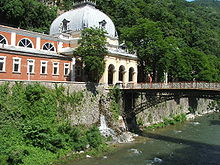Baile Herculane
|
Băile Herculane Hercules Bath Herkulesfürdő |
||||
|
||||
| Basic data | ||||
|---|---|---|---|---|
| State : |
|
|||
| Historical region : | Banat | |||
| Circle : | Caraș-Severin | |||
| Coordinates : | 44 ° 53 ' N , 22 ° 25' E | |||
| Time zone : | EET ( UTC +2) | |||
| Height : | 168 m | |||
| Area : | 105.44 km² | |||
| Residents : | 5,008 (October 20, 2011) | |||
| Population density : | 47 inhabitants per km² | |||
| Postal code : | 325200 | |||
| Telephone code : | (+40) 02 55 | |||
| License plate : | CS | |||
| Structure and administration (as of 2016) | ||||
| Community type : | city | |||
| Structure : | 1 District / cadastral municipality: Pecinișca | |||
| Mayor : | Miclău Cristian ( PNL ) | |||
| Postal address : | Mihai Eminescu Street, no. 10 loc. Băile Herculane, jud. Caraș-Severin, RO-325200 |
|||
| Website : | ||||
| Others | ||||
| City Festival : | September | |||
Băile Herculane ( German Herkulesbad , Hungarian Herkulesfürdő ) is a city and a health resort in the Caraș-Severin County , Banat , Romania .
Geographical location
Băile Herculane is located in the Banat Uplands on the Cerna River between the Cerna Mountains in the northwest and the Mehedinți Mountains in the southwest. The district capital Reșița is about 60 km northwest.
Neighboring places
| Mehadia | Valea Bolvaşnița | Baia de Aramă |
| Bozovici |

|
Motru |
| Berzasca | Orșova | Drobeta Turnu Severin |
history
The existence of the settlement since 153 is attested by a Roman inscription. During the time of the Roman Empire , Hercules Bath (Latin Ad aquas Herculi sacras ) was an important health resort named after the Greco-Roman god Heracles . Numerous archaeological finds date from this period.
After the Romans withdrew, the importance of the place declined; although the constant naming indicates that the healing springs were used continuously.
Hercules bath lost its importance in the Middle Ages and during the Turkish era . The modern spa operation began when Austria-Hungary took possession of the Banat in 1718. Field Marshal Johann Andreas Graf von Hamilton laid out new baths and opened them in 1736. The place was since 1767 in the area of the Banat military border ; part of the recreational facilities belonged to the Austro-Hungarian army ; Many spa guests came from their ranks. In 1811 there were 944 spa guests, in 1830 there were 1,431. The spa buildings were built in the Austrian baroque style . The first pavilions were built in 1801, some of which are still functional today. The buildings on both sides of the Cerna bank (Franz-Josef-Hof, Rudolf-Hof, Theresien-Hof), all late Baroque buildings, were planned by the Viennese architect Carl Wilhelm Christian von Doderer . The military border and with it the military administration of the place were dissolved in 1873.
Count Hamilton brought the finds from Roman times to Vienna. Hercules portraits were particularly common among the reliefs. A year later, Pascale Caryophilus published a dissertation in Vienna with the title “De usu et praestantia Thermarum Herculanarum quae nuper in Dacia Traiani detectae sunt” (On the use and refinement of the Herculean thermal baths recently discovered in Trajan's Dazien).
In 1847 the Hercules statue designed by the Viennese artists Romalmeyer and Glantz was erected, the landmark of the Herkulesbad. Cannon barrels were used as raw material. In the 18th and 19th centuries several Austro-Hungarian rulers visited the place, including Franz I , Joseph II , Franz Joseph I and Elisabeth . Jakob Pazeller composed the waltz Souvenir de Herkulesbad in 1903 .
After the First World War , Herkulesbad came to Romania through the Treaty of Trianon . Since then, the spa facilities have been expanded. In 1922 the Muzeul Nicolae Cena , named after the well-known general and local researcher Nikolaus Cena , was opened. He bequeathed his collections to the municipality, especially finds from the Roman fort "Ad Mediam", which are exhibited there.
After the Second World War , the place received the status of a city.
population
In 1880, 914 people lived in the area of today's city, only 336 of them in the Hercules Bath and 578 in Pecinişca , which is now incorporated . 616 were Romanians , 189 Germans and 63 Hungarians . As a result, the population increased; In 1992 the maximum was reached with 6340. In the 2002 census, 6019 inhabitants were registered, of which 5396 in the city proper and 623 in Pecinişca. 5217 identified themselves as Romanians, 67 as Roma , 51 as Hungarians, 27 as Germans and 13 as Czechs .
traffic
The railway line from Caransebeş to Orşova runs through Băile Herculane . Around ten passenger trains ran in both directions in 2009, with express trains also stopping. The train station is a few kilometers outside the city. Furthermore, the national road Drum național 67D leads to Târgu Jiu . There are regular bus connections to Orșova and many larger cities in the country.
Sightseeing and tourism
16 thermal springs of various mineral compositions are used over a length of four kilometers; There are sources containing sodium chloride , bicarbonate and calcium as well as bromine , iodine and sulfur with temperatures between 38 and 67 ° C. It treats rheumatic , orthopedic, neurological and gynecological diseases as well as diabetes , diseases of the eyes, the gastrointestinal tract and the respiratory tract.
The monuments and buildings worth seeing include the bronze statue of Hercules (1847), the spa museum with archaeological finds from Roman times, the Roman baths (Hotel Roman on the ground floor), the casino (1913) and the Austrian baths (between 1883 and 1886 after the plans of the architect Carl Wilhelm von Doderer ). Some of the spa facilities are in an unsatisfactory condition and in need of renovation. The Romanian government is planning investments to improve the infrastructure of the tourist facilities.
Băile Herculane is located in the Domogled-Valea Cernei National Park . There are several caves in the area as well as the city of Orșova, 19 km away, and the Danube Gorge Iron Gate (Cazanele mari și mici).
Born in Băile Herculane
- Friedrich von Martini (1833–1897), Swiss engineer
See also
literature
- Elke Hoffmann, Peter-Dietmar Leber and Walter Wolf : The Banat and the Banat Swabians. Volume 5. Cities and Villages , Media Group Universal Grafische Betriebe München GmbH, Munich, 2011, 670 pages, ISBN 3-922979-63-7 .
- Herbert Rosendorfer : Hercules bath. An Austrian story . Munich: Nymphenburger, 1985.
Web links
- Website of the city of Herkulesbad
- Accommodation in Herkulesbad
- from Herkulesbad
- Herkulesbad: Between agony and old splendor , ORF .at (August 21, 2016), with current images
Individual evidence
- ↑ 2011 census in Romania ( MS Excel ; 1.3 MB)
- ↑ Mayoral elections 2016 in Romania ( MS Excel ; 256 kB)
- ↑ accessed on September 27, 2009
- ↑ a b c Website of the Caraş-Severin District Council
- ^ Journal of the Society of Doctors in Vienna. 7th year, 1st volume. Carl-Gerold-Verlag, Vienna 1851, pp. 414–417
- ^ Johann Karl Schuller: Romanian folk songs. Theodor Steinhaussen publishing house. Sibiu 1859, p. 110
- ↑ a b banater-berglanddeutsche.de ( memento from October 1, 2016 in the Internet Archive ), Herkulesbad
- ^ Leonhard Böhm: History of the Temeser Banat. Part 2. Otto Wigand publishing house. Leipzig 1861. pp. 167-171
- ↑ DWH Busch et al .: Encyclopedic Dictionary of Medical Sciences. Medical Faculty of Berlin. 16th volume. Veit et Comp. Berlin 1837. pp. 111-114
- ↑ Elke Hoffmann, Peter Dietmar Leber , Walter Wolf : The Banat and the Banat Swabians. Cities and Villages Munich 2011 ISBN 3-922979-63-7
- ↑ 2002 census, accessed on May 9, 2009 (PDF; 858 kB)
- ↑ Anja Schliebitz: Romania . Baedeker, 2009. p. 369. ISBN 978-3-8297-1172-2
- ↑ Bucharest Herald of February 25, 2011, accessed on February 25, 2011 ( Memento of March 12, 2011 in the Internet Archive )





